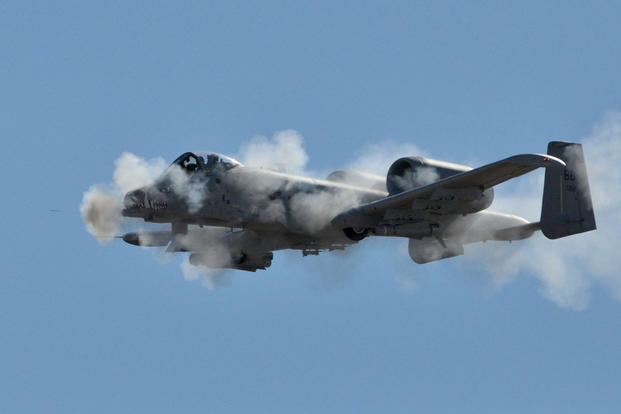A "catastrophic" engine failure aboard an A-10 Thunderbolt on a mission over Iraq forced the aircraft to make an emergency landing at the al-Asad airbase where U.S. Marines have been training Iraqi forces in in contested Anbar province, U.S. Central Command confirmed Friday.
Col. Patrick Ryder, a CentCom spokesman, told a Pentagon briefing that the engine failure was "not uncommon" for combat aircraft.
"It was just one of those things that happen when you’re operating high-performance aircraft," Ryder said of the engine failure.
Ryder declined to discuss when the incident occurred and whether the A-10 was over ISIS-controlled territory when it happened, but said the pilot was not injured and the aircraft was repaired and returned to duty.
The forced landing of the A-10 came amid renewed debate in Congress over the Air Force’s plan to mothball the aging A-10 fleet by 2018.
Related Video
Supporters of the attack A-10s, including Senate Armed Services Committee Chairman Sen. John McCain, R-Ariz., kept funding alive for the A-10 program last year and have pledged to do the same this year in the National Defense Authorization Act for what they call the nation’s premier ground attack aircraft.
In an Air Force release, the 332nd Expeditionary Maintenance Squadron gave a detailed account of the extraordinary effort to repair the plane at the al-Asad airbase west of Baghdad that was not equipped for the fix.
The number one engine on the A-10C Thunderbolt II "suffered catastrophic damage during a routine refueling mission and the pilot was able to safely land the aircraft at the air base," the release said.
The Air Force dispatched a nine-member team to conduct the repairs. "This was a very important mission," said Col. Michael Stohler, the 332nd Maintenancer.
"The aircraft was in a location that was not fully secure and we needed it repaired and flown out of there as quickly as possible," Stohler said. The al-Asad airbase has periodically come under attack from the Islamic State of Iraq and Syria but there have been no U.S. casualties.
Getting across what he needed done to Army troops and Marines on the ground also presented a problem, Stohler said.
"Communicating fighter aircraft needs to Marine and Army personnel presented many unique challenges," Stohler said.
"There is absolutely no aircraft maintenance equipment, air ground equipment, or any way to tow fighter aircraft" at al-Asad, Stohler. "We had to bring everything we needed and improvise everything else. We worked on the jet in an unused aircraft shelter the Iraqi air force used once upon a time. It had no lights, no power, no phone, and no internet -- just a roof over our heads."
Just getting the A-10 into the makeshift hangar was difficult. "We tried to back it in using the truck -- no joy," Stohler said. "We tried to use a large Marine fork lift to push it in -- no joy. In the end, 12 airmen and two Marines pushed the 40,000-pound aircraft 70 yards uphill into the hangar."
It took five days to repair the plane to the point where it could fly back to its original base at an undisclosed location in the region.
"The pilot did an outstanding job of flying this difficult-to-handle aircraft to a safe landing," Stohler said. "The maintenance team did an awesome job of returning it to the air."
-- Richard Sisk can be reached at richard.sisk@military.com




























